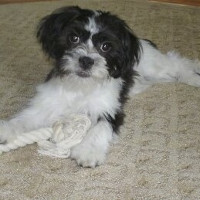Appearance of the Ja-Chon
|
| The Ja-Chon is a small dog like its two parent breeds. The Japanese Spaniel has a broad head with large, wide-set eyes and a flat brachiocephalic face. Its ears are small and V-shaped, with long hair covering them. These dogs have an underbite. The tail is curled over the back with feathered hairs along the tail. The coat is white with colored patches, the most common colors being black, red, lemon, orange, sable, black and white with tan points or brindle. The Bichon frise is generally all white, with a double coat. Its coat is soft, but always stands out from the body, giving the Bichon a "puffy" appearance. The Ja-Chon is likely to have medium-length hair that can be wavy. It may also have colored patches on its body. The exact color will depend on the Chin's color palette. |
Temperament of the Ja-Chon
|
| The Ja-Chon will be a blend of the personalities of its parent breeds. Owners describe their hybrid as having a sense of humor, a gift for entertaining and a tendency towards independence. He's no stranger to separation anxiety, even if left alone for long periods. He likes to be the center of attention and is appreciated by everyone who comes into contact with him. He is highly intelligent and easily trained. With kind and considerate handling, your Ja-Chon will thrive on obedience due to its eager-to-please personality. |
Needs and activities of the Ja-Chon
|
| The Ja-Chon is a low-activity dog. He likes to play, however, and will do well in an apartment or house as long as he gets daily exercise. This can take the form of outdoor play in a fenced yard or brisk walks with the owner. He could also enjoy a trip to the dog park. However, remember that this small dog doesn't need to overwork himself physically, but will be happiest when his inquisitive mind also has the opportunity to work. Short training sessions will allow him to excel at pleasing as he loves to do, while allowing him to practice his concentration skills. |
Maintenance of the Ja-Chon
|
| The Ja-Chon will have medium-length hair, and it can be wavy. It can stand out from the body as the hair of the parent breed Bichon frise tends to do. It can also be short and dense. Brush your Ja-Chon at least once a week to make sure there's no matting. Bathe only when necessary. You should brush your Ja-Chon's teeth at least three times a week, however, if you want to prevent gum disease, brush the dog's teeth every day. Trim your dog's nails every two weeks. If grooming time is enjoyable for your Ja-Chon, he'll look forward to the time spent together and allow a proper check of his teeth, nails and ears. |









 English (United Kingdom)
English (United Kingdom)